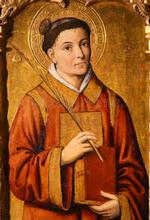Make your gift today!
Help keep Catholics around the world educated and informed.
Already donated? Log in to stop seeing these donation pop-ups.
Catholic Recipe: Ciastka Miodowe (Honey Cakes)
Also Called: Ciasteczka miodowe
Saint Nicholas has been for hundreds of years a popular saint in the East and in the West, greatly famed as a worker of miracles. There are many charming legends concerning him. One tells of an occasion in heaven when all the saints came together to talk and to drink a little wine. Saint Basil filled the golden cups from the golden jug, and everyone was deep in conversation when it was noticed that Saint Nicholas was nodding. One of the blessed nudged him until he awoke, and asked why he was slumbering in such good company.
"Well, you see," he told them, "the enemy has raised a fearful storm in the Aegean. My body was dozing perhaps, but my spirit was bringing the ships safe to shore."
Saint Nicholas is the saint of mariners and also of bankers, pawnbrokers, scholars, and thieves! But he is especially the saint of children, and is known among them in various countries as Santa Claus, Kris Kringle, Pelznickel. There have even been invented servants to accompany him and to deal with the children who have been bad. Saint Nicholas is considered too kind to give scoldings and punishments, so, in Austria Krampus, in Germany Knecht Rupprecht, and in Holland Black Peter go along with him, armed with a stout switch, while Saint Nicholas himself simply gives and gives.
Another very old legend tells us of the saint's kindness to the three daughters of a poor nobleman. They were about to be sold into slavery, because they had no dowry, when Saint Nicholas stole to their home and on three nights in succession dropped a bag of gold down the chimney. This is said to explain why three balls are the pawnbrokers' sign and why the saint drops gifts for children down the chimney.
Devotion to Saint Nicholas began in Asia Minor, where he was a bishop, and it was brought to Russia by an emperor who was witness to some of his miraculous works. It spread through Lapland and into Scandinavia, to other European countries, and finally to America. Up to that time Saint Nicholas had been pictured as a lean and ascetic bishop. In America, he became fat and jolly, and his miter was turned into a winter cap, his vestments into a snow suit. But he has kept his reindeer from Lapland, his propensity for chimneys acquired in Asia Minor, and the generosity of his heart.
A French legend tells that long ago Our Lady gave Lorraine to Saint Nicholas as a reward for his kindness to the world. He is still the special patron of that province and on his eve children hang up their stocking, saying:
Saint Nicolas, mon bon patron Envoyez-moi quelqu' chose de bon.
In Poland if there is a red sunset on Saint Nicholas' Day, it is because the angels are busily baking the Saint's Honey Cakes, or Ciastka Miodowe.
DIRECTIONS
Warm the honey slightly and combine with the sugar. Add eggs and beat well. Sift the flour with the soda and spices and stir into the honey batter thoroughly. Let the dough rest overnight. Roll dough to 1/4-inch thickness; cut out with a cooky cutter. Brush with the slightly beaten white of an egg, press half a blanched almond into each cooky and bake at 375° F. for about fifteen minutes.
Recipe Source: Feast Day Cookbook by Katherine Burton and Helmut Ripperger, David McKay Company, Inc., New York, 1951





